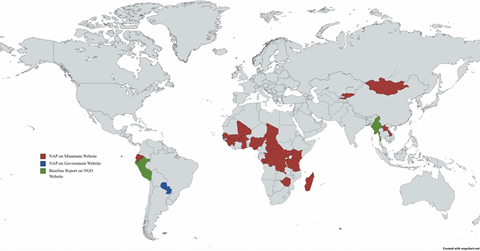An international treaty to cut mercury in gold mining isn’t working because the reported estimates of the heavy metal’s use are inaccurate, according to a six-year study.
New research into mercury use in gold mining in 25 countries – many of them in Africa, South America and Asia – found the figures they report under the Minamata Convention can be very different to the amounts of mercury they really use. In some cases, the estimates are so poor that they can hide whether any genuine reductions in mercury use are being made at all, says study author Kathleen Smits, a professor of civil and environmental engineering at the Southern Methodist University in the US.
‘Their baseline emissions are based on calculations that are just all over the map,’ Smits tells Chemistry World. ‘There’s no consistency or standard in how they have to gather their data or how they have to report that data.’

Smits and her colleagues analysed the mercury estimates reported by 25 countries under the Minamata Convention, which are based on data given by miners and other participants in the gold industry, ratios that calculate the mercury needed to produce every ounce of gold and inspections of known mining operations. They found that a country’s estimate can vary widely when only a few data sources are used to extrapolate national mercury use, and that different countries use different metrics to create their estimates.
Mercury has been used to extract gold from slurries of water and sediments for centuries, and it’s still a relatively inexpensive method for small-scale miners. The mercury sticks to particles of gold and carries the amalgam to the bottom of a bucket or pond, where it’s collected. The mercury is then burned-off, and the remaining slurry – which still contains mercury – is dumped.
Smits explains that workers use masks and makeshift fume hoods to avoid the gases, but the mercury builds up in the environment. In particular, microbes in water transform mercury into the potent neurotoxin methylmercury, which accumulates in the fish consumed by animals and humans.
The UN estimates about 15 million people are exposed to mercury from gold mining, including up to five million women and children. The build-up of mercury can lead to major health problems, with debilitating effects on the nervous, digestive and immune systems that can even be fatal. Mercury is especially harmful to children, and to pregnant women.
Smits says good alternatives to mercury extraction exist, but the method has been used for generations and many of the illegal operations that buy gold also supply mercury. ‘It’s sickly linked,’ she says. ‘If you want to sell your gold on the illegal gold market, then you have to purchase mercury from the same illegal operation.’
She hopes the new study will lead to improvements in the national estimates reported under the Minamata Convention, such as using more data to estimate the amounts of mercury each country uses, and more detailed agreements between countries about how the estimates should be calculated. Smits also hopes that efforts at some gold-mining localities to cut mercury use can be replicated elsewhere, even if mercury isn’t entirely done away with.
Lee Bell, a mercury policy advisor for IPEN, a network of environmental health NGOs, says one method to address the problem is to require countries to account for the use of all the mercury they produce or import. ‘While some mercury may be used for dental amalgam, most other products and processes using mercury have been phased out,’ he says. ‘Therefore, there should be little demand for mercury outside the [gold mining] sector.’
References
M Schwarz, K Smits, T Phelan, Environ. Sci. Policy, 2023, 141 (DOI: 10.1016/j.envsci.2022.12.002)












No comments yet